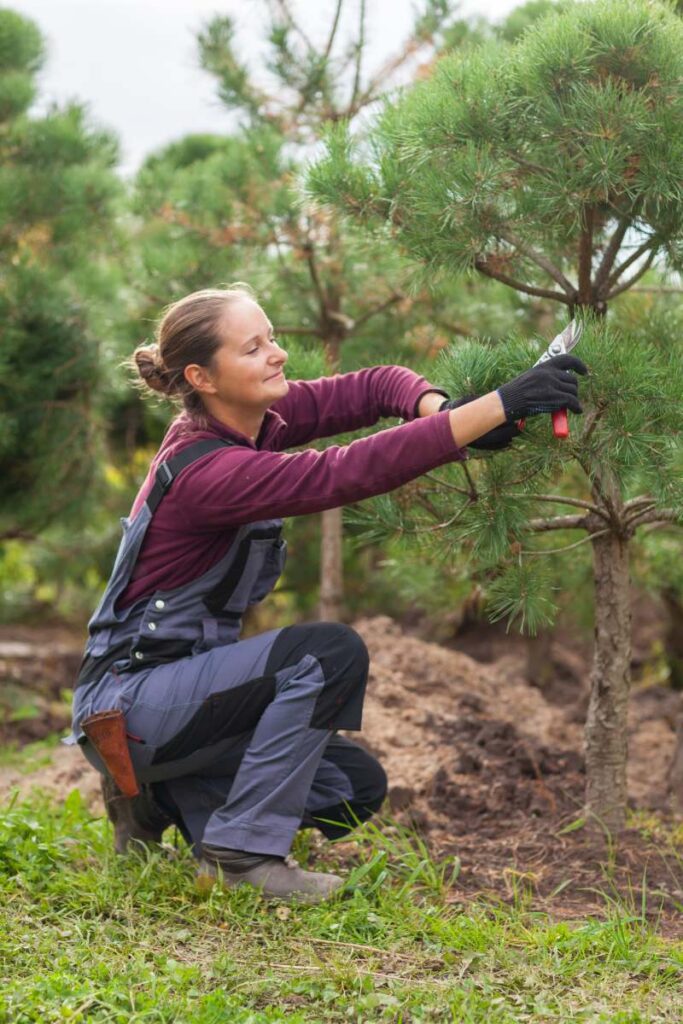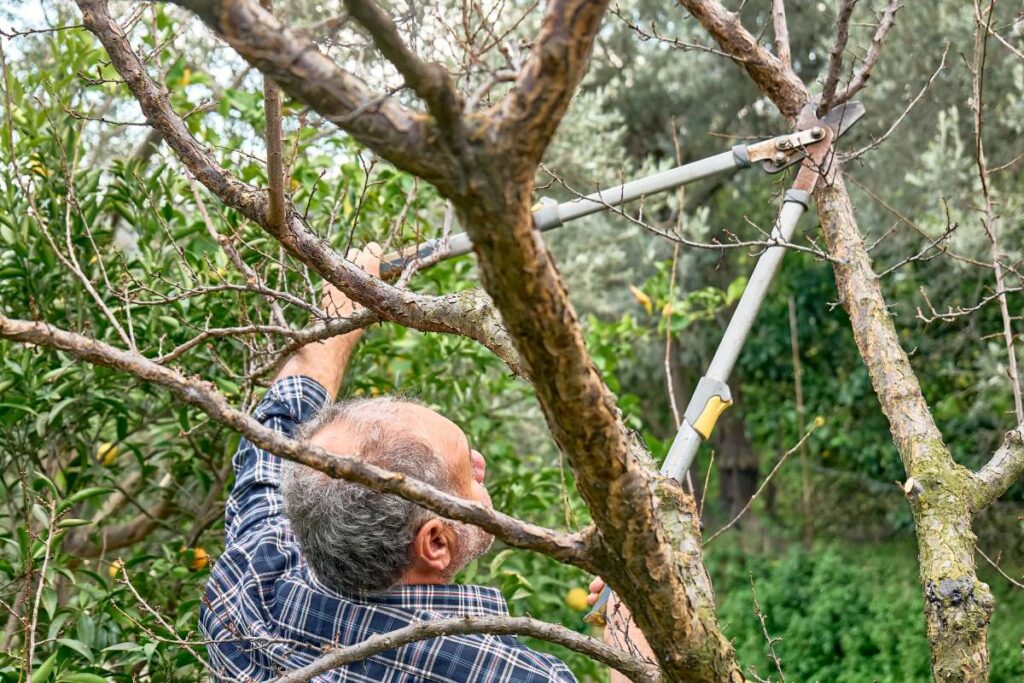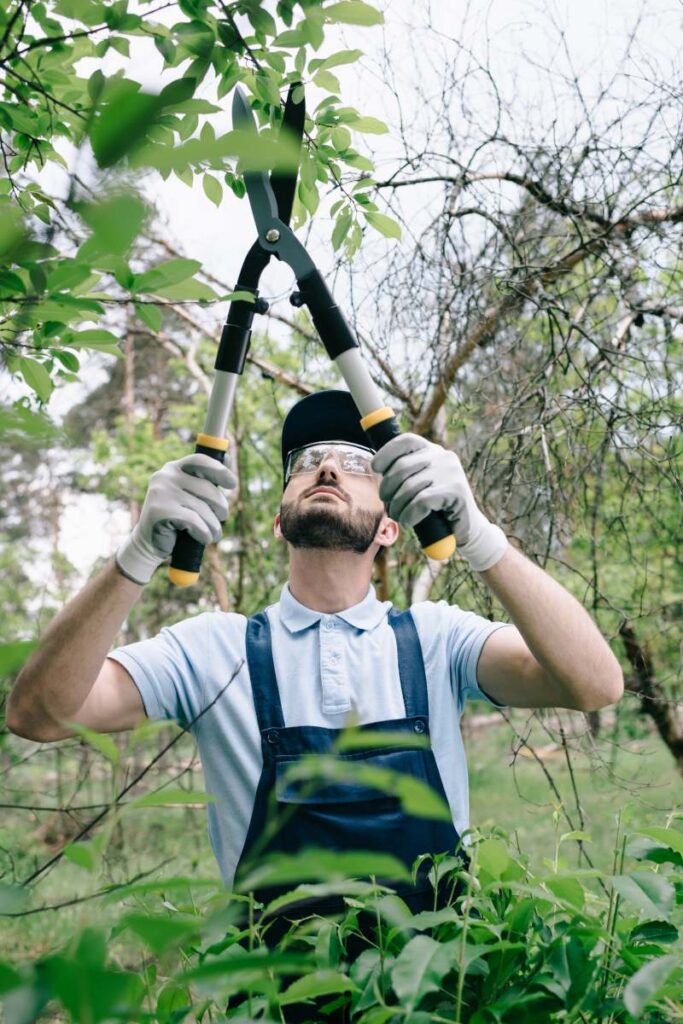Pruning trees can be part of your redecoration or renovate your yard. But how much do you know about how to do it?
Pruning trees offers numerous benefits, with safety being paramount. Dead branches pose a constant risk of falling, endangering people, buildings, and power lines. Removing hazardous limbs and maintaining tree safety is crucial.
Yet, pruning can also be hazardous, especially for large trees or hard-to-reach branches. For your safety, it’s best to enlist an expert like AB Tree Pruning for pruning tasks that you aren’t completely comfortable or confident in handling yourself.
Why pruning trees is important?
Pruning trees is a crucial practice for maintaining the health, safety, and aesthetics of trees in various environments, from urban landscapes to natural forests. It involves selectively removing branches or stems to benefit the tree as a whole. Here are the key reasons why pruning trees is important:
1. Health and Growth
Pruning helps in maintaining tree health by removing dead, diseased, or damaged branches. Dead branches can be a breeding ground for pests and diseases, which can spread to other parts of the tree or nearby trees. By cutting off these branches, you prevent the spread of harmful organisms. Additionally, pruning allows for better air circulation and sunlight penetration, which are essential for photosynthesis. This process promotes healthier and more vigorous growth.
2. Safety

Overgrown or improperly growing branches can pose significant safety hazards. Branches that hang over homes, power lines, or streets can fall during storms or high winds, causing damage to property and endangering lives. Regular pruning removes these potential hazards before they become a problem. It also helps maintain clear visibility on roads and sidewalks, reducing the risk of accidents.
3. Aesthetics
Pruning enhances the visual appeal of trees and landscapes. It helps in shaping the tree and controlling its size, ensuring it fits well within its surroundings. Well-maintained trees can significantly enhance the aesthetic value of a property, making it more attractive to residents, visitors, and potential buyers. Artistic pruning, such as topiary or bonsai, can also create visually striking and unique tree shapes.
4. Fruit Production
For fruit trees, pruning is especially important. It encourages the growth of new fruiting wood and helps manage the size and shape of the tree for easier harvesting. By removing non-productive or weak branches, the tree can direct more energy into producing healthy and abundant fruit. Pruning also ensures that fruits receive adequate sunlight and air, which can improve their quality and size.
5. Structural Integrity
Pruning helps in developing a strong tree structure. Young trees, in particular, benefit from formative pruning, which establishes a solid framework of branches. This structural training prevents future problems and reduces the risk of breakage or splitting. By guiding the growth of a tree early on, you can prevent costly corrective pruning later.
6. Disease Prevention
Certain tree diseases can be mitigated through proper pruning techniques. For example, pruning to increase air circulation can reduce the likelihood of fungal infections. By removing infected branches promptly, you can also stop diseases from spreading throughout the tree or to nearby trees.
7. Environmental Benefits
Healthy, well-maintained trees contribute significantly to the environment. They provide shade, reduce energy costs, improve air quality, and support wildlife. By pruning trees, you ensure they remain healthy and continue to offer these benefits. Healthy trees also sequester carbon dioxide more effectively, playing a role in combating climate change.

When is the best time of year to prune trees?
The best time to prune trees generally depends on the type of tree and the specific goals of the pruning. However, there are some general guidelines that can help you determine the optimal time for pruning most trees.
Late Winter to Early Spring
For many trees, the best time to prune is in late winter to early spring, just before new growth starts. During this period, trees are still in their dormant phase, which has several advantages:
- Less Stress on Trees: Pruning during dormancy reduces the stress on trees. They are not actively growing, so the cuts heal more slowly, but more effectively, with less risk of disease and pest infestation.
- Better Visibility: With no leaves, the tree’s structure is more visible, making it easier to identify which branches need to be removed or trimmed.
- Encourages Vigorous Growth: Pruning just before the spring growth spurt stimulates strong growth. This is particularly beneficial for trees that need to recover from damage or disease.
Specific Timing for Different Trees
- Deciduous Trees: Most deciduous trees, like oaks, maples, and birches, are best pruned in late winter while they are dormant.
- Flowering Trees: Timing for pruning flowering trees depends on when they bloom. Trees that flower in spring (like dogwoods and cherries) should be pruned immediately after they bloom. Trees that flower in summer (like crepe myrtles) should be pruned in late winter or early spring.
- Fruit Trees: Fruit trees also benefit from late winter pruning. This timing helps shape the tree, remove dead or diseased wood, and encourage the growth of new fruiting wood.
Avoiding Specific Times
- Fall: Pruning in the fall is generally not recommended. Cutting branches during this time can stimulate new growth that may not have enough time to harden before the onset of winter, making the tree vulnerable to damage from cold weather.
- Spring (During Bud Break): Avoid heavy pruning during the time when buds are breaking open and new growth is starting. This period is critical for the tree’s energy reserves, and heavy pruning can stress the tree.
- Summer: Pruning in mid to late summer is typically avoided unless it’s for corrective purposes. This period can also attract insects and expose the tree to more stress.
Exceptions and Special Cases
- Evergreens: These can generally be pruned any time of year, but late winter to early spring is still the preferred time for most species.
- Dead or Diseased Branches: These should be removed as soon as they are noticed, regardless of the time of year. Prompt removal helps prevent the spread of disease and reduces hazards.
Regional Considerations
The best time to prune can also vary depending on the local climate. For instance, in regions with milder winters, the window for dormant-season pruning may be extended. In areas with harsh winters, it’s important to complete pruning before the worst of the winter weather sets in.
How many types of tree pruning techniques?
There are several tree pruning techniques, each serving different purposes and achieving specific outcomes for tree health, safety, and aesthetics. Here are the main types of tree pruning techniques:
1. Crown Thinning
Purpose: To reduce the density of branches, allowing more light and air to penetrate the canopy.
Description: This involves selectively removing branches throughout the tree’s crown. It helps to reduce wind resistance and weight, which can minimize the risk of storm damage. Thinning should be done evenly across the canopy to maintain the tree’s natural shape.
2. Crown Raising

Purpose: To lift the lower edge of the tree’s crown.
Description: This technique involves removing the lower branches of the tree. It provides clearance for pedestrians, vehicles, and buildings, improving visibility and access. Crown raising is commonly used in urban areas to prevent obstruction.
3. Crown Reduction
Purpose: To decrease the overall size of the tree’s crown.
Description: Crown reduction involves cutting back the tree’s branches to reduce its height and spread. This technique is often used when a tree has grown too large for its location and poses a risk to structures or power lines. Careful cuts are made to lateral branches to ensure the tree retains a natural appearance and balance.
4. Crown Cleaning
Purpose: To remove dead, diseased, or damaged branches.
Description: This involves the removal of non-living parts of the tree. Crown cleaning helps to prevent decay and the spread of disease, reducing hazards from falling branches. It is a common maintenance practice that improves the tree’s health and safety.
5. Deadwooding
Purpose: To remove dead wood specifically.
Description: Similar to crown cleaning but focused solely on eliminating dead branches. Deadwooding is crucial for safety, especially in areas where falling branches could pose a danger to people or property.
6. Pollarding
Purpose: To maintain trees at a specific height and shape.
Description: Pollarding involves cutting back the tree’s branches to the trunk or main stems. New shoots grow from these cuts, which are pruned regularly to maintain the desired size and shape. This technique is often used for aesthetic purposes or to control the size of trees in restricted spaces.
7. Topping
Purpose: To reduce the height of a tree drastically.
Description: Topping involves cutting the main branches back to stubs or lateral branches. This technique is generally discouraged because it can lead to weak, poorly structured growth and make the tree more susceptible to disease and pests. However, it may be used as a last resort for trees that pose a significant risk and cannot be managed through other pruning techniques.
8. Espalier
Purpose: To train trees to grow flat against a support structure.
Description: This is a specialized technique used primarily for fruit trees. Branches are pruned and trained to grow along a framework, creating a two-dimensional form. Espalier is often used for decorative purposes and to maximize space in small gardens.
9. Vista Pruning
Purpose: To create or enhance a specific view.
Description: This involves selectively removing branches to open up views or sightlines. It is often used in landscaping to improve the visibility of certain features, such as a scenic vista or architectural element.
10. Restoration Pruning
Purpose: To restore the natural structure and appearance of a tree that has been improperly pruned or damaged.
Description: This involves selectively removing unwanted growth and reshaping the tree. Restoration pruning may take several years to achieve the desired results, gradually correcting structural issues and improving the tree’s health and appearance.
Each tree pruning technique serves a distinct purpose, whether for enhancing tree health, safety, aesthetics, or practical needs like clearance and size control. Understanding these techniques allows for proper tree care, ensuring that trees remain healthy, safe, and visually appealing.
If you’re in the Perth area and you’re not sure how to prune your trees properly or need any assistance with tree pruning, you can consult with AB Tree Pruning for the best result.
Final thought
It’s crucial to avoid over-pruning trees. Ideally, prune minimally to achieve your desired outcome. Never remove more than 25% of a tree’s crown, where most leaves are found and where it derives its energy. Pruning excessively and quickly can fatally harm the tree.
For professional tree pruning, it’s wise to hire a certified arborist who can ensure the job is done correctly and safely from the start. If you’re considering tree trimming services, reach out to the experienced tree care specialists at AB Tree Pruning.






